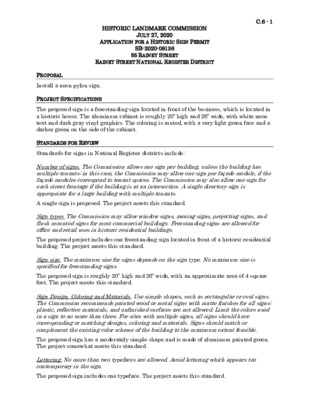C.6 - SB-2020-09136 - 85 Rainey St — original pdf
Backup

HISTORIC LANDMARK COMMISSION APPLICATION FOR A HISTORIC SIGN PERMIT JULY 27, 2020 SB-2020-09136 85 RAINEY STREET RAINEY STREET NATIONAL REGISTER DISTRICT C.6 - 1 PROPOSAL Install a neon pylon sign. PROJECT SPECIFICATIONS The proposed sign is a freestanding sign located in front of the business, which is located in a historic house. The aluminum cabinet is roughly 20” high and 26” wide, with white neon text and dark gray vinyl graphics. The coloring is muted, with a very light green face and a darker green on the side of the cabinet. STANDARDS FOR REVIEW Standards for signs in National Register districts include: Number of signs. The Commission allows one sign per building, unless the building has multiple tenants; in this case, the Commission may allow one sign per façade module, if the façade modules correspond to tenant spaces. The Commission may also allow one sign for each street frontage if the building is at an intersection. A single directory sign is appropriate for a large building with multiple tenants. A single sign is proposed. The project meets this standard. Sign types. The Commission may allow window signs, awning signs, projecting signs, and flush mounted signs for most commercial buildings. Freestanding signs are allowed for office and retail uses in historic residential buildings. The proposed project includes one freestanding sign located in front of a historic residential building. The project meets this standard. Sign size. The maximum size for signs depends on the sign type. No maximum size is specified for freestanding signs. The proposed sign is roughly 20” high and 26” wide, with an approximate area of 4 square feet. The project meets this standard. Sign Design, Coloring and Materials. Use simple shapes, such as rectangular or oval signs. The Commission recommends painted wood or metal signs with matte finishes for all signs; plastic, reflective materials, and unfinished surfaces are not allowed. Limit the colors used in a sign to no more than three. For sites with multiple signs, all signs should have corresponding or matching designs, coloring and materials. Signs should match or complement the existing color scheme of the building to the maximum extent feasible. The proposed sign has a moderately simple shape and is made of aluminum painted green. The project somewhat meets this standard. Lettering. No more than two typefaces are allowed. Avoid lettering which appears too contemporary in the sign. The proposed sign includes one typeface. The project meets this standard. C.6 - 2 Lighting. Lighting must be indirect, and may be accomplished through shielded incandescent lights attached to the top of the sign, “halo” lighting, or recessed can lighting in awnings. Internally-lit cabinet signs are not allowed for signs on historic buildings or within the historic districts. Not applicable. Neon Signs. Neon signs are prohibited on pre-1950 building facades; an exception may be made for existing pre-1950 neon signage, or with photographic proof of a historic (pre-1950) neon sign on the building, but only if the neon sign does not detract from the historic character of the building or area. The Commission may consider limited neon on a post- 1950 façade, but encourages backlit neon over exposed neon. The proposed sign includes neon letters and graphics. Staff feels that the neon sign does not detract from the character of the Rainey Street National Register District, which has seen substantial modern new construction and other changes. Stagger Lee and Augustine, the businesses next door and across the street, feature similar freestanding neon signs. Sign Placement. Flush-mounted and projecting (blade) signs should be positioned near the business entrance immediately above the principal entry to the business. Single-tenant signs are not allowed over doorways serving multiple tenants. As required by the city land development code, the bottom of the sign shall be a minimum of nine (9) feet above the sidewalk. When feasible, place signs to align with others in the block. Signs should not obscure or cover architectural elements, such as windows, decorative banding, or other ornamentation. The proposed sign will be located in front of the building. Sign Mounting. New signs should utilize existing mounting apparatus whenever possible. If new bolt holes or brackets are necessary for sign installation, care should be taken to ensure that installation does not damage historic building materials in any way. Bolting through mortar joints avoids damage to historic stone or brick. Not applicable. COMMITTEE RECOMMENDATIONS Not reviewed. STAFF RECOMMENDATION Approve the sign. Neon falls outside the purview of administrative approval, but the Rainey Street National Register District includes many modern signs, in addition to large modern buildings, and the sign will not detract from the remaining historic character of the district. PHOTOGRAPHS C.6 - 3 85 Rainey Street. Source: Google Street View, October 2019. 85 Rainey Street, looking north. Source: Google Street View, October 2019.